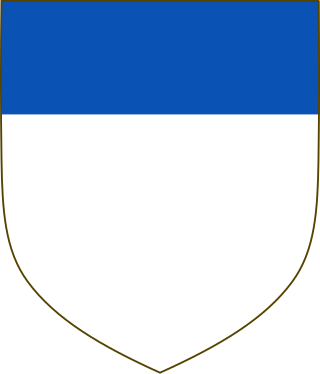Related Research Articles

Matilda of Tuscany, also referred to as la Gran Contessa, was a member of the House of Canossa in the second half of the eleventh century. Matilda was one of the most important governing figures of the Italian Middle Ages. She reigned in a period of constant battles, political intrigues and Roman Catholic excommunications, and was able to demonstrate an innate and skilled strategic leadership capacity in both military and diplomatic matters.
Otto was count of Savoy from around 1051 until his death. Through marriage to Adelaide, the heiress of Ulric Manfred II, he also administered the march of Susa from around 1046 until his death.
Amadeus II was the count of Savoy from 1078 to 1080. His life is obscure and few documents mention him. During his rule, he was overshadowed by his mother, but he had good relations with the papacy and, for a time, the Holy Roman emperor.

Peppino De Filippo was an Italian actor.

Manfred I was the founder and first ruler of the marquisate of Saluzzo from 1142 until his death.

Boniface del Vasto was the margrave of Savona and Western Liguria from 1084 to c.1130. He was the son and successor of Otto and of Bertha, daughter of Ulric Manfred II of Turin. Boniface was a member of the Aleramici dynasty.
Ulric Manfred II or Manfred Ulric was the count of Turin and marquis of Susa in the early 11th century. He was the last male margrave from the Arduinid dynasty. Ulric Manfred's daughter, Adelaide, inherited the majority of his property. Through marriage to Adelaide, Otto of Savoy, a younger son of Count Humbert I of Savoy became margrave of Turin. Their descendants would later comprise the House of Savoy who ruled Sardinia and Italy.
The March or Marquisate of Turin was a territory of medieval Italy from the mid-10th century, when it was established as the Arduinic March. It comprised several counties in Piedmont, including the counties of Turin, Auriate, Albenga and, probably, Ventimiglia. The confines of the march thus stretched across the Po Valley from the Western Alps in the north, to the Ligurian Sea.
Arduin Glaber was count of Auriate from c. 935, count of Turin from c. 941/942, and Margrave of Turin from c. 950/964. He placed his dynasty, the Arduinici, on a firm foundation and established the march of Turin through conquests and royal concessions. The Chronicon Novaliciense, the chronicle of the abbey of Novalesa, is the primary source for his life.
Manfred I or Maginfred was the second Arduinici marquis of Susa from 977 until his death. Manfred was the eldest son of Arduin Glaber, from whom he inherited the county of Auriate and the vast March of Susa. The march extended from the Susa Valley by the Alps south across the Po to the Ligurian Sea. Although he ruled for almost twenty-five years, there is little evidence of his activities in surviving sources. Under him, Pavia became a mercantile city. He also controlled the road between Genoa and Marseilles.

Adelaide of Turin was the countess of part of the March of Ivrea and the marchioness of Turin in Northwestern Italy from 1034 to her death. She was the last of the Arduinici. She is sometimes compared to her second cousin and close contemporary, Matilda of Tuscany.

Adolfo Fumagalli was a 19th-century Italian virtuoso pianist and composer, known today primarily for his virtuosic compositions for the left hand alone.

The 1261 papal election took place after the death of Pope Alexander IV on 25 May and chose Pope Urban IV as his successor. Since Pope Alexander had been resident in Viterbo since the first week of May 1261, the meeting of the cardinals to elect his successor took place in the Episcopal Palace at Viterbo, which was next to the Cathedral of S. Lorenzo. The actual date of the beginning of the Electoral Meeting is unknown. If the canon of Pope Boniface III were still in effect, then the Election could not begin until the third day after the Pope's burial.
Bertha of Milan or Bertha of Luni, was a duchess of Turin by marriage to Ulric Manfred II of Turin, and regent for her daughter Adelaide of Susa in 1033.
The Laterza culture or Laterza-Cellino San Marco culture is an Eneolithic culture in Southern Italy. It takes its name from the tombs discovered in the locality of Laterza, near Taranto, and Cellino San Marco, near Brindisi, in Apulia. It developed in Apulia and Basilicata, and to a lesser extent of Central Italy in the 3rd millennium BC, around 2950-2350 BC. As with many of the cultures of the late prehistoric period, it is known essentially from the style of pottery recovered from archaeological digs. The culture was defined in 1967 by Francesco Biancofiore, following research in a necropolis of the same name situated to the north-west of the city of Taranto, in southern Apulia.
Amizo of Turin was an Italian bishop. He was bishop of Turin from 966 until his death in 1000. Based on an early modern Milanese chronicle, it is sometimes argued that Amizo was the son of Arduin Glaber of Turin.
Vitelmo of Turin or William of Turin was an Italian bishop. He was bishop of Turin from c. 1082 until his death in 1092.

Chiara Frugoni was an Italian historian and academic, specialising in the Middle Ages and church history. She was awarded the Viareggio Prize in 1994 for her essay, Francesco e l'invenzione delle stimmate.
John Moulton Day was an American historian.
References
- ↑ Lazzari, 'Aziende fortificate,' p. 101.
- ↑ Fumagalli, Origini, pp. 30ff., 81f.; Sergi, ‘Una grande circoscrizione,’ pp. 660f.; Violante, ‘Quelques caractéristiques,’ pp. 108f.
- ↑ G. Drei, Le carte degli archivi parmensi del secolo XII (Parma, 1950), no. 78 (March 991, Pavia), pp. 238ff.
- ↑ Lazzari, 'Aziende fortificate,' p. 99.
- ↑ Previté-Orton (1912), pp. 149, 165 f.